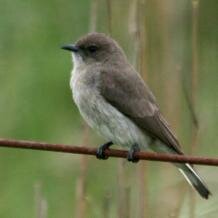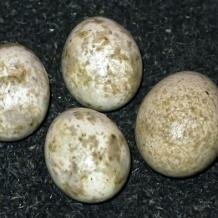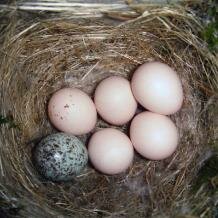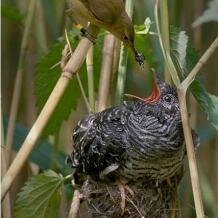Topic: Brood parasitism in cuckoos and other birds
Obligate brood parasitism has evolved several times independently in birds. Apart from the cuckoos, it can be found in four other, only distantly related families.
One of the most famous – or rather infamous – birds is the common cuckoo (Cuculus canorus). Instead of caring for its offspring, this species is an obligate brood parasite that has lost the ability to nest and uses host parents of other species to raise its young. This had long puzzled naturalists, but Charles Darwin recognised the advantage of such a behaviour. Breeding is dangerous, time consuming and energetically costly and by ridding itself of all parental duties, the cuckoo is able to lay more eggs. Thus, it is not surprising that other birds have adopted a parasitic breeding strategy as well. Quite a lot of species are facultative parasites, which raise their own brood but also lay eggs in the nests of conspecifics, while obligate brood parasitism occurs in about 1% of all bird species.
Distribution and evolutionary origins of brood parasitism
Obligate brood parasitism has evolved several times independently in different avian lineages, hence representing a good example of convergent evolution. Although cuckoos are the most well-known parasitic birds, it is important to note that not all members of the widely distributed Cuculidae family cheat. Only 59 of 141 species are full-time parasites, while the remaining 82 species provide care for their young.  Until recently, it was unclear how many times brood parasitism has evolved within this family, but molecular phylogenetic analyses have now suggested three independent evolutionary origins: in a New World lineage containing three parasitic species; in the Old World crested cuckoos in the genus Clamator; and in the common ancestor of 52 Old World Cuculini species. Parasitic cuckoos most likely evolved from parental species some tens of millions of years ago. The adoption of the parasitic lifestyle was associated with changes in ecological and life-history traits, like a shift to more open habitat and an increase in migratory behaviour.
Until recently, it was unclear how many times brood parasitism has evolved within this family, but molecular phylogenetic analyses have now suggested three independent evolutionary origins: in a New World lineage containing three parasitic species; in the Old World crested cuckoos in the genus Clamator; and in the common ancestor of 52 Old World Cuculini species. Parasitic cuckoos most likely evolved from parental species some tens of millions of years ago. The adoption of the parasitic lifestyle was associated with changes in ecological and life-history traits, like a shift to more open habitat and an increase in migratory behaviour.
Apart from the cuckoos, obligate brood parasitism can be found in four other, only distantly related bird families. Two of them belong to the order Passeriformes – the New World Icteridae and the Old World Viduidae. The remarkably adaptable and successful icterids include American blackbirds, bobolinks and grackles as well as five species of parasitic cowbirds. These constitute the genus Molothrus, meaning “intruder” in Latin. 
 The viduids, comprising indigobirds and whydahs, are small parasitic African finches. In addition to the 19 species in the genus Vidua, this family now also contains the cuckoo finch (Anomalospiza imberbis). This species had originally belonged to the weavers in the family Ploceidae, suggesting two evolutionary origins of brood parasitism in African finches. However, recent molecular studies assigned it to the Viduidae, implying that brood parasitism has evolved only once in African finches. Furthermore, also a group of non-passerine African birds employs hosts to raise their offspring. These are the honeyguides in the family Indicatoridae, which belong to the order Piciformes that also contains the woodpeckers. Their breeding biology is still not particularly well-known, but it is assumed that all 17 species are obligate brood parasites and derived from a common ancestor. Finally, one species of South American duck, the black-headed duck (Heteronetta atricapilla) in the family Anatidae of the order Anseriformes lays its eggs in the nests of other species.
The viduids, comprising indigobirds and whydahs, are small parasitic African finches. In addition to the 19 species in the genus Vidua, this family now also contains the cuckoo finch (Anomalospiza imberbis). This species had originally belonged to the weavers in the family Ploceidae, suggesting two evolutionary origins of brood parasitism in African finches. However, recent molecular studies assigned it to the Viduidae, implying that brood parasitism has evolved only once in African finches. Furthermore, also a group of non-passerine African birds employs hosts to raise their offspring. These are the honeyguides in the family Indicatoridae, which belong to the order Piciformes that also contains the woodpeckers. Their breeding biology is still not particularly well-known, but it is assumed that all 17 species are obligate brood parasites and derived from a common ancestor. Finally, one species of South American duck, the black-headed duck (Heteronetta atricapilla) in the family Anatidae of the order Anseriformes lays its eggs in the nests of other species.
Convergent features of brood parasites
To succeed in exploiting their hosts, all parasitic species share certain characteristics. These adaptations are necessary, because hosts suffer considerably from parasitism; they experience reduced reproductive success and frequently produce no offspring at all. Therefore, hosts are under strong selective pressure to evolve defences against parasitism. The parasite responds to these defences by evolving more and more elaborate parasitic strategies, resulting in a co-evolutionary arms race between parasite and host. This interaction with the host, as well as different degrees of host specialisation, has led to a number of differences between parasitic species. However, as all are faced with the same problems, they show key similarities.
To begin with, all parasite females have to place their eggs into the host’s nest after the host female has started laying. If they are seen and recognised as an enemy, their chances of parasitizing the nest will be greatly reduced. So to avoid detection they have to act quickly and often lay only a single egg per host nest. The female of the common cuckoo, for example, only needs ten seconds to dispose of one host egg and replace it with her own. Removing a host egg might not only make it more difficult for the host to spot parasitism, but also reduce competition for the parasite chick, so many parasitic birds do it.
Once the parasite egg has been laid, it has to remain in the host nest. If the host recognises it as foreign, it will chuck it out, rendering the parasite unsuccessful. Thus, brood parasites commonly lay mimetic eggs that try to match their host’s eggs as closely as possible.  Egg mimicry is especially accurate in those species that have specialised on a particular host, like most cuckoos. In Europe, there are distinct host-races of the common cuckoo as individual females only use one of 15 possible songbird host species. Daughters probably inherit the host preference from their mother as well as the matching egg type. However, egg mimicry is not always employed. If the host is unable to identify odd eggs, for example because it has been acquired by the parasite relatively recently and has not yet had sufficient time to evolve the ability to do so, there is no need for the parasite to mimic eggs closely. This could explain why British dunnocks (Prunella modularis), which lay bright blue eggs, accept the greyish cuckoo egg instead of throwing it out.
Egg mimicry is especially accurate in those species that have specialised on a particular host, like most cuckoos. In Europe, there are distinct host-races of the common cuckoo as individual females only use one of 15 possible songbird host species. Daughters probably inherit the host preference from their mother as well as the matching egg type. However, egg mimicry is not always employed. If the host is unable to identify odd eggs, for example because it has been acquired by the parasite relatively recently and has not yet had sufficient time to evolve the ability to do so, there is no need for the parasite to mimic eggs closely. This could explain why British dunnocks (Prunella modularis), which lay bright blue eggs, accept the greyish cuckoo egg instead of throwing it out.  Furthermore, not all brood parasites are specialists that can match their eggs closely to those of the host. Cowbirds are generalists; the well-studied brown-headed cowbird (Molothrus ater) has been reported to use more than 200 different host species. So cowbird eggs are often clearly recognisable and ejected by many hosts.
Furthermore, not all brood parasites are specialists that can match their eggs closely to those of the host. Cowbirds are generalists; the well-studied brown-headed cowbird (Molothrus ater) has been reported to use more than 200 different host species. So cowbird eggs are often clearly recognisable and ejected by many hosts.
After hatching, the parasite chick needs to outcompete host offspring in the battle for parental attention. All parasites have rapid development times, which gives them an advantage from the start. However, they still deal with their competitors in different ways. Most cuckoos and honeyguides simply do not tolerate host chicks in the nest. The young of honeyguides and New World cuckoos possess sharp hooks on their beaks, allowing them to destroy host eggs or kill host nestlings. In most Cuculini species, the chick ejects host eggs or young from the nest immediately after hatching. To elicit care from the host parents, both cuckoo and honeyguide chicks have extremely loud begging calls that mimic an entire brood of host young – without such vocal mimicry, the parasite might be deserted. In contrast, Clamator cuckoos, cowbirds and African finches tolerate the company of host chicks in the nest. Young Clamator cuckoos beg more vigorously than host young and therefore normally outcompete them. Cowbird chicks are larger and more aggressive but actually benefit from the company of host chicks, because collectively they induce a higher level of care from the host parents than the parasite could on its own. Vidua nestlings show remarkable visual similarity to the nestlings of the closely related estrildid finch species that they parasitize; during begging, they display exactly the same intricate gape markings. These markings may help the parents locate the chicks’ mouths in the dimly lit domed nest and also stimulate feeding. It has been assumed that the Vidua chicks mimic the host chicks to avoid rejection by the host parents. Recently, however, it has been suggested that it could be the other way round in that the parasite could have come up with elaborate, care-attracting gape markings, which the host young would then need to match in order to receive sufficient food from their parents. Black-headed ducks differ markedly from all the other brood parasites as they do not remain in the nest requiring care from host parents. They are precocial, i.e. leave the nest soon after hatching and wander off to find food on their own.
In contrast, Clamator cuckoos, cowbirds and African finches tolerate the company of host chicks in the nest. Young Clamator cuckoos beg more vigorously than host young and therefore normally outcompete them. Cowbird chicks are larger and more aggressive but actually benefit from the company of host chicks, because collectively they induce a higher level of care from the host parents than the parasite could on its own. Vidua nestlings show remarkable visual similarity to the nestlings of the closely related estrildid finch species that they parasitize; during begging, they display exactly the same intricate gape markings. These markings may help the parents locate the chicks’ mouths in the dimly lit domed nest and also stimulate feeding. It has been assumed that the Vidua chicks mimic the host chicks to avoid rejection by the host parents. Recently, however, it has been suggested that it could be the other way round in that the parasite could have come up with elaborate, care-attracting gape markings, which the host young would then need to match in order to receive sufficient food from their parents. Black-headed ducks differ markedly from all the other brood parasites as they do not remain in the nest requiring care from host parents. They are precocial, i.e. leave the nest soon after hatching and wander off to find food on their own.
So all these different groups of birds, which have evolved brood parasitism independently, have come up with similar solutions to trick the host into providing care. The particular behaviours and strategies they employ might differ though, particularly because they have been shaped by co-evolutionary interactions with their different hosts.
Cite this web page
Map of Life - "Brood parasitism in cuckoos and other birds"
https://mapoflife.org/topics/topic_553_brood-parasitism-in-cuckoos-and-other-birds/
November 29, 2020

